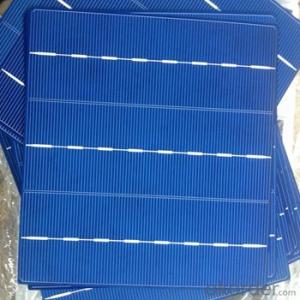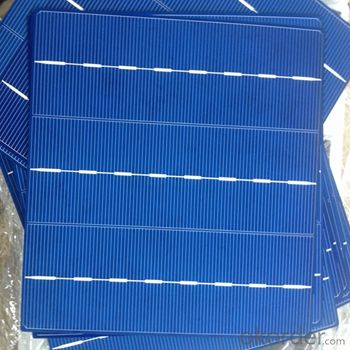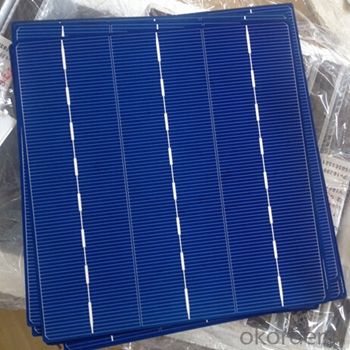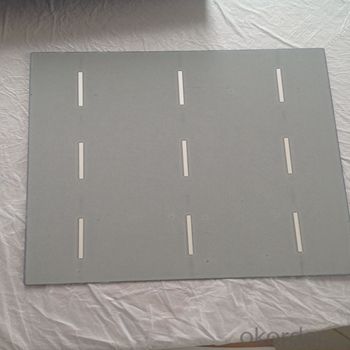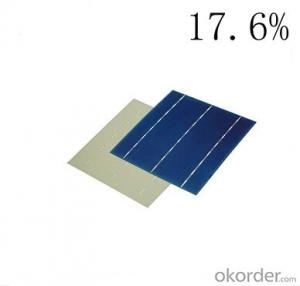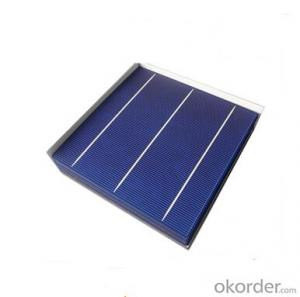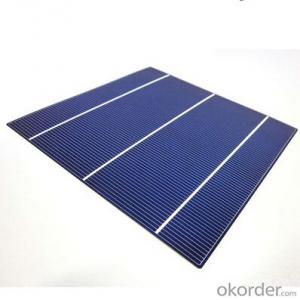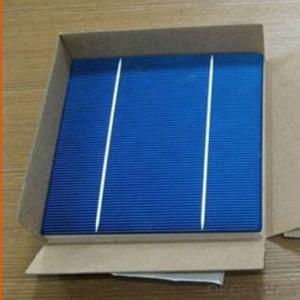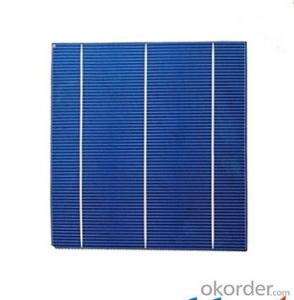Highest Efficiency Polycrystalline Solar Cells with Stable Performance
- Loading Port:
- Shanghai
- Payment Terms:
- TT or LC
- Min Order Qty:
- 5000 pc
- Supply Capability:
- 9000000 pc/month
OKorder Service Pledge
OKorder Financial Service
You Might Also Like
Polycrystalline Silicon Solar Cells:
Solar cells is made by solar wafer, it has three categories of solar cell right now, monocrystalline polycrystalline and thin film,These cells are entirely based around the concept of ap-n junction, which is the critical part of solar module, it is the part that can convert the light energy into electricity, the thickness is from 180um to 200um, with even busbars to conduct electricity, textured cell can decrease diffuse reflection; they are often electrically connected and encapsulated as a module. Photovoltaic modules often have a sheet of glass on the front (sun up) side, allowing light to pass while protecting semiconductor wafers from abrasion and impact due to wind-driven debris, rain, hail, etc. Solar cells are also usually connected in series in modules, creating an additive voltage. Connecting cells in parallel will yield a higher current;With high quality and stable quality. Our Cells can greatly improve the performance of Solar Modules.
Polycrystalline Silicon Solar Cells Advantage:
• High efficiency and stable performance in photovoltaic conversion.
• Advanced diffusion technique ensuring the homogeneity of energy conversion efficiency of the cell.
• Advanced PECVD film forming, providing a dark blue silicon nitride anti-reflection film of homogenous color and attractive appearance.
• High quality metal paste for back surface and electrode, ensuring good conductivity, high pulling strength and ease of soldering.
• High precision patterning using screen printing, ensuring accurate busbar location for ease with automatic soldering a laser cutting.
Specification:
Mechanical data and design |
Format - 156 mm × 156 mm ± 0.5 mm |
Thickness- - 200 μm ± 20 μm |
Front (-) - 1.4 mm bus bars (silver),blue anti-reflection coating (silicon nitride) |
Back (+) - 2 mm wide soldering pads (silver) back surface field (aluminium) |
Temperature Coefficient of Cells |
Voc. Temp .coef.%/K -0.364%/K |
Isc . Temp .coef.%/K +0.077%/K |
Pm. Temp. coef.%/K -0.368%/K |
Electrical Characteristic |
Efficiency (%) Pmpp (W) Umpp (V) Impp (A) Voc (V) Isc (A) |
18.00% 4.380 0.538 8.141 0.634 8.740 |
17.90% 4.356 0.538 8.097 0.634 8.725 |
17.80% 4.331 0.537 8.065 0.633 8.710 |
17.70% 4.307 0.536 8.035 0.632 8.695 |
17.60% 4.283 0.535 8.006 0.631 8.680 |
17.50% 4.258 0.534 7.974 0.630 8.665 |
17.40% 4.234 0.533 7.944 0.629 8.650 |
17.30% 4.210 0.532 7.914 0.628 8.635 |
17.20% 4.185 0.531 7.88 -- 0.627 -- 8.620 |
17.10% 4.161 0.530 7.851 0.626 8.605 |
17.00% 4.137 0.529 7.820 0.625 8.590 |
Intensity Dependence |
Intensity [W/m2] Isc× [mA] Voc× [mV] Pmpp |
1000 1.00 1.000 1.00 |
900 0.90 1.000 0.90 |
800 0.80 0.99 0.80 |
500 0.50 0.96 0.49 |
300 0.30 0.93 0.29 |
200 0.20 0.92 0.19 |
IV Curve

Solar Panel Images:
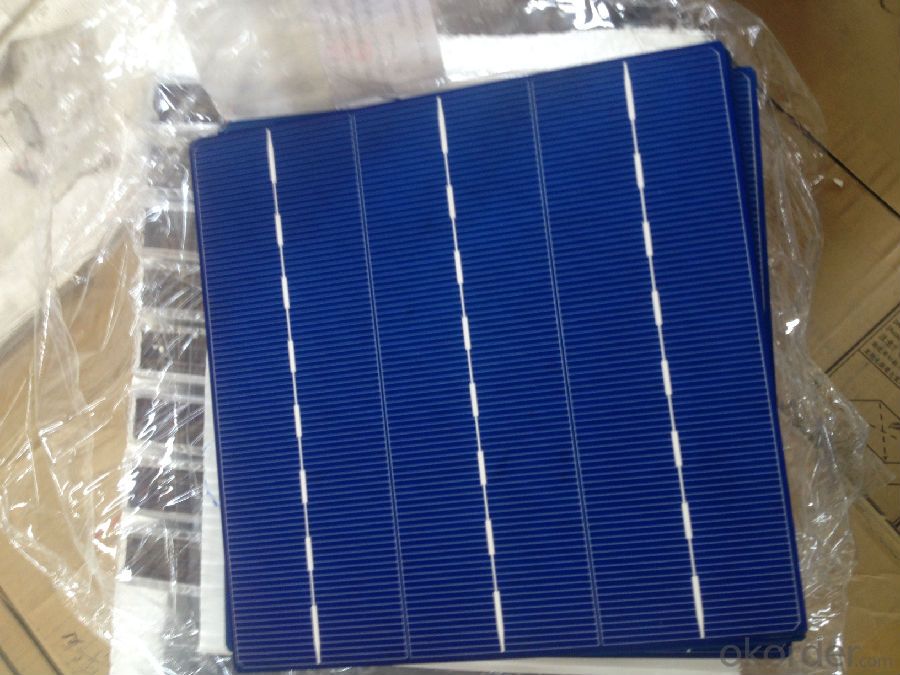

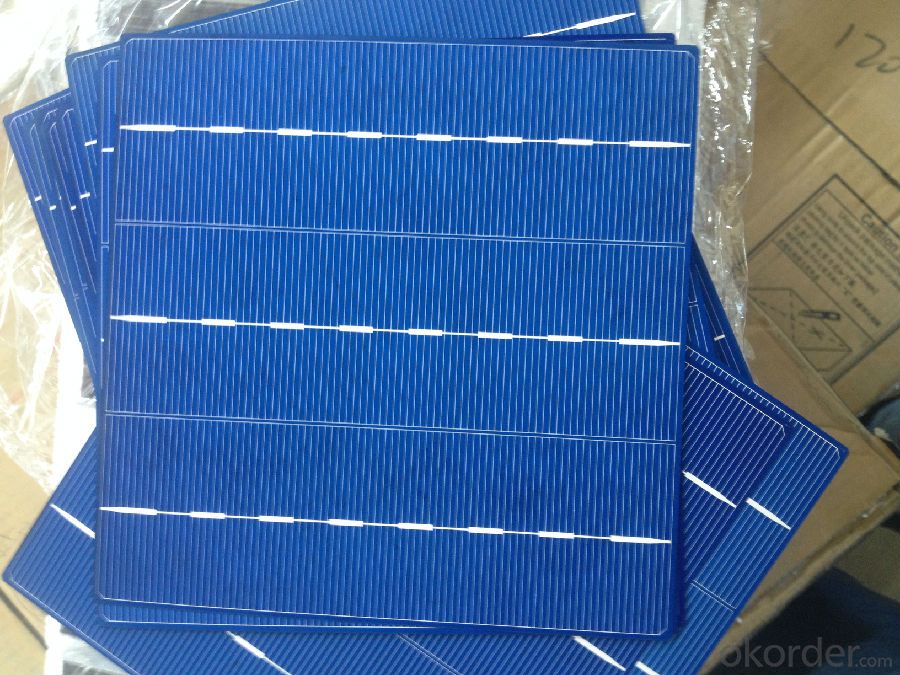
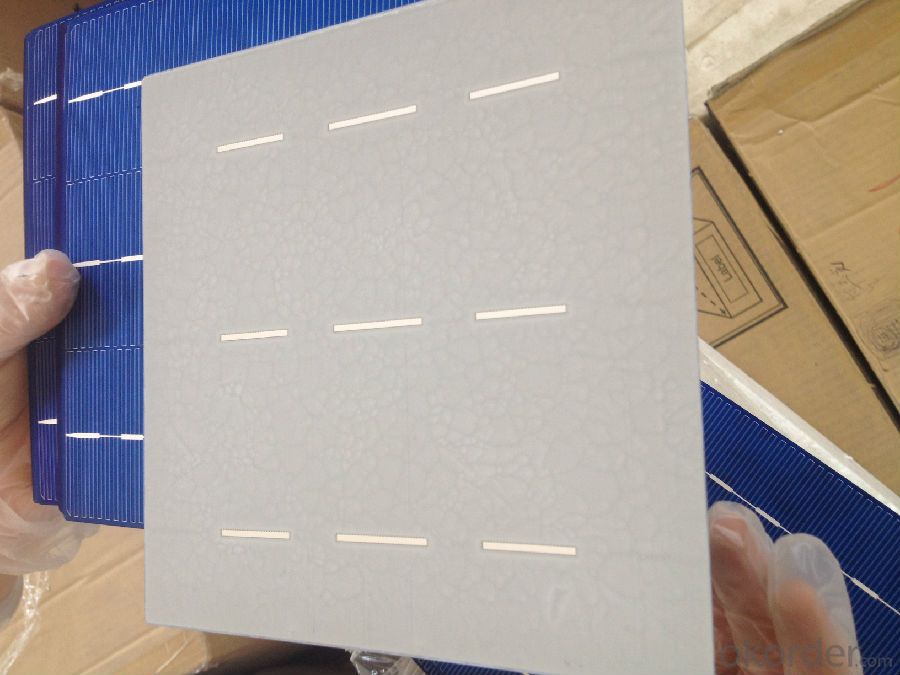
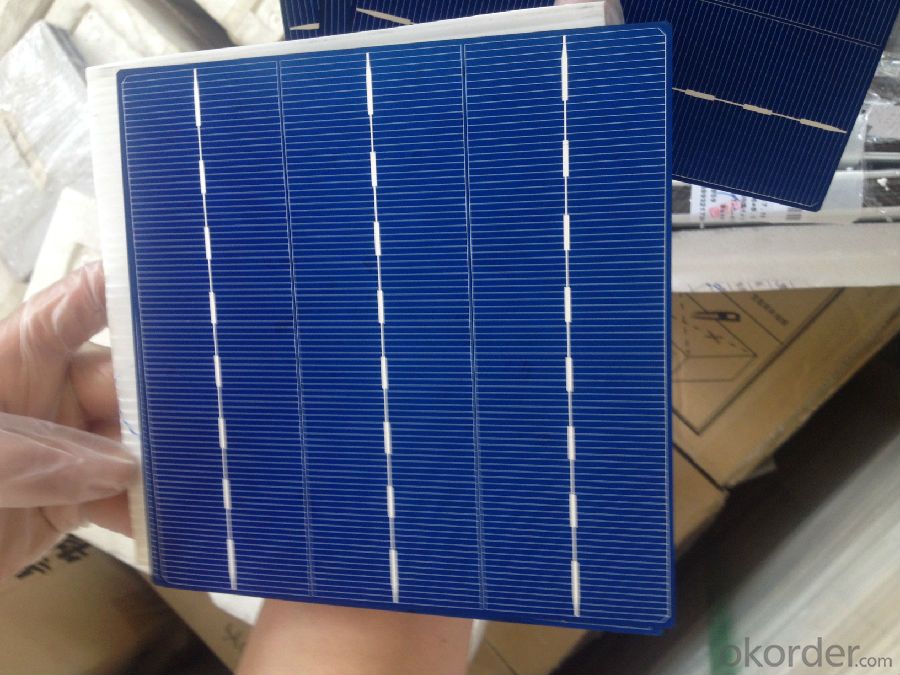
FAQ
We have organized several common questions for our clients,may help you sincerely:
①What price for each watt?
It depends on the efficiency of the solar cell, quantity, delivery date and payment terms.
②How long can we receive the product after purchase?
In the purchase of product within three working days, We will arrange the factory delivery as soon as possible. The pecific time of receiving is related to the state and position of customers.Commonly 7 to 10 working days can be served.
③Can you provide the peripheral products of the solar panels, such as the battery, controller, and inverter? If so, can you tell me how do they match each other?
Yes, we can, we have two companies for solar region, one is CNBM International, the other is CNBM engineering Co.
We can provide you not only the solar module but also the off grid solar system, we can also provide you service with on grid plant.
④What is your warranty of solar cell?
Our product can promise lower than 0.3% open box crack, we support claim after opening the box if it has crackm color difference or sth, the buyer should give pictures immediately, we can not accept the claim after the solar cell has assembled to solar panel.
• Timeliness of delivery
• ⑤How do you pack your products?
We have rich experience on how to pack the solar cell to make sure the safety on shipment, we could use wooden box or pallet as buyer's preference.
⑥ Can you do OEM for us?
Yes, we can.
New Achievement of Chinese solar cell research
Professor Xiong Yujie group from China Science and Technology University have designed a photoelectric conversion can be carried out and has a flexible solar cell mechanics in the near infrared region based on the widely used semiconductor silicon material, the use of hot electron injection method of metallic nanostructures. Most solar cells are for visible light absorption, accounting for 52% of the sunlight near-infrared light has not been used efficiently. To solve this problem, based on previous research group Xiong Yujie semiconductor - metal interface, creatively having a near-infrared light absorption properties of silver nano-chip with integrated silicon nanowires to build two different photovoltaic devices, the near infrared region photoelectric conversion characteristics are improved. In the near-infrared light, the silver nano-chip generated hot electrons can be injected directly into the silicon semiconductor, the band of the photoelectric conversion.
In addition, conventional solar cells must be processed into hard plate-like objects, which limit daily use. Lightweight and flexible devices, and can be folded, crimped, pasted on a surface, such as automotive glass, roof, clothes. Xiong Yujie group of commercial silicon nano process combined with silver nano-sheet near-infrared light absorption properties, to create a near-infrared solar cell having mechanical flexibility.
Experts said the work by nano-manufacturing and nano-synthesis two kinds of nano effective combination of technologies to achieve a broad spectrum of the light-absorbing composite structures design and the development of a simple and effective near-infrared flexible solar cell manufacturing method is expected to for the development of smart thermostat and wearable solar cells solar cells.
- Q: What is the impact of hurricane-force winds on solar cell efficiency?
- Hurricane-force winds can have a significant impact on solar cell efficiency. These strong winds can cause physical damage to the solar panels, such as breaking or displacing them, which directly affects their ability to generate electricity. Additionally, debris and flying objects carried by the winds can scratch or shatter the protective glass covering the solar cells, reducing their efficiency further. Therefore, the impact of hurricane-force winds on solar cell efficiency is generally negative and can result in a temporary or permanent decrease in energy production.
- Q: Can solar cells be used in electric bikes or scooters?
- Yes, solar cells can be used in electric bikes or scooters. By integrating solar panels onto the vehicle's surface, they can capture sunlight and convert it into electricity to charge the battery. This can help extend the range of the electric bike or scooter and reduce the reliance on grid-based charging. However, the amount of energy generated by the solar cells may be limited, so it may not fully replace the need for traditional charging methods.
- Q: Can solar cells be used to power parking meters?
- Yes, solar cells can be used to power parking meters. Solar cells convert sunlight into electricity, which can be used to power various devices including parking meters. This helps reduce the dependence on traditional energy sources and promotes sustainability.
- Q: Can solar cells be used in public charging stations for electric vehicles?
- Yes, solar cells can be used in public charging stations for electric vehicles. By harnessing solar energy, these charging stations can provide clean and renewable power to charge electric vehicles, reducing reliance on traditional grid electricity and contributing to a more sustainable transportation system.
- Q: What is the role of voltage regulators in solar cell systems?
- The role of voltage regulators in solar cell systems is to ensure that the voltage output from the solar cells remains constant and within a specific range. They regulate the voltage to match the requirements of the connected devices or batteries, preventing overcharging or damage to the system. Voltage regulators also help maximize the efficiency of the solar cells by optimizing the power output.
- Q: Anybody ever heard of solar roll flexible solar panel?
- It could be a portable solar panel charges your digital camera, camcorder, GPS, and satellite phone. Expedition members no longer need to pack heavy batteries for their worldwide journeys.
- Q: Can solar cells be used in clothing?
- Yes, solar cells can be used in clothing.
- Q: How do solar cells impact global warming?
- Solar cells have a positive impact on global warming as they generate clean, renewable energy by converting sunlight into electricity, reducing the reliance on fossil fuels. By utilizing solar cells, we can decrease greenhouse gas emissions and mitigate climate change.
- Q: Can solar cells be used to power water pumps or irrigation systems?
- Yes, solar cells can be used to power water pumps or irrigation systems. Solar panels convert sunlight into electricity, which can then be used to power water pumps and irrigation systems, providing a sustainable and renewable source of energy.
- Q: Can solar cells be used in public transportation?
- Yes, solar cells can be used in public transportation. Solar panels can be installed on the roofs of buses, trains, and trams to generate electricity from sunlight. This renewable energy can be used to power various systems in public transportation, such as lighting, air conditioning, and even charging onboard devices. Additionally, solar cells can also be used to charge electric vehicles used in public transportation, reducing reliance on fossil fuels and contributing to a more sustainable transportation system.
Send your message to us
Highest Efficiency Polycrystalline Solar Cells with Stable Performance
- Loading Port:
- Shanghai
- Payment Terms:
- TT or LC
- Min Order Qty:
- 5000 pc
- Supply Capability:
- 9000000 pc/month
OKorder Service Pledge
OKorder Financial Service
Similar products
Hot products
Hot Searches
Related keywords
